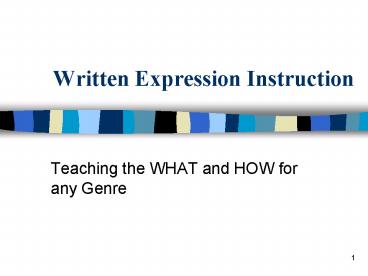Written Expression Instruction - PowerPoint PPT Presentation
1 / 21
Title:
Written Expression Instruction
Description:
Writing Process. 8. WHAT. Ask yourself, what are the CRITICAL ATTRIBUTES of a well-written product. ... Revise to improve writing based on rubric and/or the ... – PowerPoint PPT presentation
Number of Views:174
Avg rating:3.0/5.0
Title: Written Expression Instruction
1
Written Expression Instruction
- Teaching the WHAT and HOW for any Genre
2
Anita L. Archer, Ph.D. archerteach_at_aol.com
3
Variety of Genre
- List genre.
4
Brainstorming
- Think
- Students record ideas.
- Teacher monitors and writes ideas and names on
transparency. - Pair
- Students share ideas with partners.
- Teacher monitors and writes ideas and names on
transparency. - Share
- Teacher shares ideas with class using
transparency.
5
BIG IDEAS
- Teach a limited number of genre.
- Have students write many products.
- Scaffold instruction.
- M T W T F
- I do it. We do it. We do it. We do it.
We do it. - M T W T F
- You do it. .. You do it. You do
it.
6
BIG IDEAS
- Consider motivation.
- Success (perceived probability of success)
- Interest (interest in the topic)
- Choice (narrow choice when possible)
7
BIG IDEAS
- WHAT
- Critical attributes
- Rubric
- Illustrate with an example
- HOW
- Writing Process
8
WHAT
- Ask yourself, what are the CRITICAL ATTRIBUTES of
a well-written product. - Six Traits
- Ideas
- Organization
- Word Choice
- Voice
- Sentence Fluency
- Conventions
9
What
- Represent in a simple, easy to understand RUBRIC.
(See example rubrics.) - Consider introducing only a portion of the rubric
initially. Focus on ideas, organization, and
conventions. - Provide an EXAMPLE to illustrate the critical
attributes.
10
WHAT
- Example 1
- descriptive paragraph rubric and example
11
HOW
- Writing process (Examples 4 and 5)
- Plan
- Draft
- Revise
- Edit
- Publish
12
HOW - PLAN
- Prepare
- T Topic A Audience P Purpose
- Prepare Think
- Brainstorm
- Research
13
HOW - PLAN
- Organize
- Support for organization of product
- Writing frames
- Strategies
- Think Sheets
14
HOW - PLAN
- 0rganize
- Writing frames
- Use with beginning writers. (Example 5)
- Use as an accommodation for emerging writers.
(Example 6) - Use to support specialized writing. Example 7)
- Use to support summarization. (Example 8 and 9)
15
HOW - PLAN
- Organize
- Strategy for Paragraph Writing
- - List
- - Cross-out
- - Connect
- - Number
- ( Write)
- REWARDS PLUS (Sopris West)
16
HOW - PLAN
- Example 10 and 11
- Think sheet for organizing compare/contrast
- Example paragraph
17
How - PLAN
- Organize
- Examples
- Example 12
- Think sheet for short story
- Example 13
- Think sheet for personal experience
- Example personal experience
18
How - Draft
- Transcribe ideas and transcribe into
- Complete sentences that vary in length and
complexity, - Well organized paragraphs with topic sentences
and supportive details and facts, and - Longer written products with coherent beginnings
and endings. - Model transcribing.
- Guide students in the process.
19
How - REVISE
- Revise to improve writing based on rubric and/or
the traits that have been emphasized. - Ideas
- Organization
- Word Choice
- Sentence Fluency
- Voice
- Model the process of revising.
- Guide students in revising.
20
How - EDIT
- Edit writing for conventions including
- Spelling
- Capitalization
- Puntuation
- grammar
21
How - PUBLISH
- Publish a legible document.
- For selected products,
- Have students copy edited product.
- Stress the need for legible handwriting so that
others can read the product. - Celebrate Celebrate Celebrate































